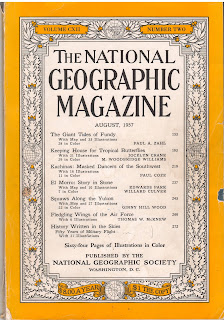If Elizabeth and Lota had been busy in the final weeks of
their stay in the US, they
were even busier once they returned to Brazil. Bishop’s next extant letter
to Grace is dated 11 December 1957. If others were written and sent, they no
longer survive. Undoubtedly, Bishop did let Grace know when they were safely
back in Brazil,
but perhaps it was just a postcard, which vanished into time’s vast vaults.
These vaults hold many lost and forgotten communications. Even so, it might
have taken Bishop that long to settle down enough to write, the prompt of
approaching Christmas bringing her to the letter she perhaps had wanted to
write all along.
Another issue in the delay was Brazilian bureaucracy. After
expressing her hope that her missive would reach Grace “in time for your
Christmas,” in spite of the “slow mails” at “this time of year,” Bishop
informed her aunt that her delay was partly because she was “waiting for my
Christmas cards that I bought in New
York to show up!” But they, along with much else,
were “still in the customs … and now they’ll have to wait until next
Christmas.”
Since returning, Elizabeth and Lota had been trying to free
their many boxes and barrels from Brazilian customs. Bishop noted, “Poor Lota
has been to Rio three times now and still half
our stuff is there.” They both had to make another trek “next week” to keep at
the bureaucrats, who had, “at one point … lost all our papers — including both
our passports!” Bishop’s word for this slog was “maddening.”
After being away for months, Lota’s family had its own
demands. Bishop wrote that the “two oldest ‘grandchildren’” were visiting. Old
being a relative term: “aged 3 and 4½.” Their mother had just had her fourth
child, another girl, so the older siblings needed tending. The newborn was
named after Lota, “‘Maria Carlota’ and
nicknamed ‘Lotinha’, or ‘Little Lota’.” If these toddlers weren’t enough, “the
cook’s new baby is here, too … three months [old].” As well as Betty (Bishop’s
namesake), who would be three in February. Bishop acknowledged the “big
responsibility” these little ones brought to Lota. Musing on the nursery that
surrounded her, Bishop wrote, “You’d think that two old maids could avoid all
this fuss about little shoes, cod liver oil, bowel movements, haircuts, etc. —
but apparently not!”
The straw on the camel’s back of all this activity was the
“horrible weather since we’ve been back.” So bad was it that Bishop could count
the sunny days on one hand: “exactly three sunny days so far.” The “pouring
rain” meant the children were more or less housebound: “You should hear me
trying to tell stories in Portuguese!”
Winding down her letter, Bishop apologized for its poor
quality, “but I think you owe me one.” Her brief epistle was meant to carry the
“small present” (the usual money, with an echo of her previous claim that it
would have been bigger “if I weren’t so broke after my N.Y. trip”).
Suddenly realizing that she had forgotten an important
update, she added, “I love having the pictures.” The grandchildren were
intrigued by them, too. They “think they’re my mother and father, and asked all
about them.” When Helena
asked, “What did they die of?” Bishop directed her, “go and ask your
Grandmother … so she went and asked Lota.”
One thing that becomes clear in this letter is that Grace
was back in the US, in Florida. In Hollywood, FL,
to be exact, where Hazel Bulmer Snow lived. Hazel was Arthur and Mabel Bulmer’s
daughter, so another of Grace’s nieces.
Hazel had been living in Florida for some time. Mabel, a widow of
five years, was spending the winter with her daughter. Grace joined them.
Clearly, Grace had been in touch about this recent development (it was not
“news” to Bishop), so perhaps it was Bishop who really owed a letter. Bishop
wrote, “I’ll try to get a card for Aunt Mabel in Petrópolis today.” And
concluded this brief, jumbled letter with a plea: “I am very eager to hear from
you and learn what you’re doing, if you’ve got a job, etc., and how you’re
liking it there.”
While not as far south as Key West,
Hollywood was in southern Florida. Having been in that neck of the
woods relatively recently, it is clear Bishop was pleased that Grace was
experiencing something of the “state with the prettiest name.” Scribbled in
Bishop’s gnomic holograph, at the bottom of the page, was her acknowledgement
that Grace would find it “strange,” having her “1st Christmas in the tropics!
They put off fire-works — or used to.”
Distracted, with little left to say, Bishop signed off with
love to her cousin and two aunts. If you would like to see a photograph of
Grace and Mabel in Florida,click here. And Mabel and her daughter Hazel, click here.
The next post makes up for December’s brevity, but when 1958
is well underway.














